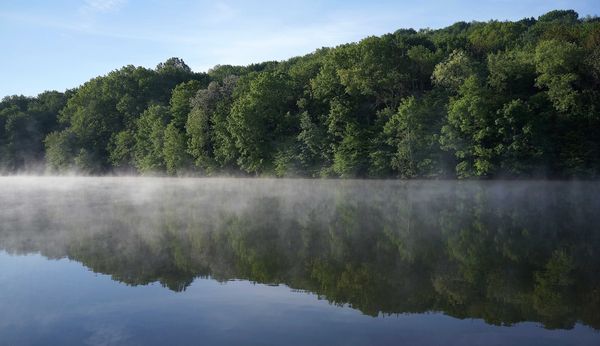Check out AI Artistry and Creation section of our forum.
HDR questions
May 31, 2013 19:06:58 #
So... if I have this correct, since my D3100 doesn't bracket or do HDR, I use a tripod, take one picture in A priority with the correct exposure, stop it both up and down by one with the shutter speed and then use a program to blend them all together.
May 31, 2013 19:24:28 #
CocoaRoger wrote:
So... if I have this correct, since my D3100 doesn't bracket or do HDR, I use a tripod, take one picture in A priority with the correct exposure, stop it both up and down by one with the shutter speed and then use a program to blend them all together.
yes
May 31, 2013 19:30:09 #
Check out Film Photography section of our forum.
May 31, 2013 19:33:48 #
CocoaRoger wrote:
So... if I have this correct, since my D3100 doesn't bracket or do HDR, I use a tripod, take one picture in A priority with the correct exposure, stop it both up and down by one with the shutter speed and then use a program to blend them all together.
Hand held (no tripod) 6400 iso. Canon 5DII<doesn't do HDR. Did not use bracketing feature. First opened in Lightroom. Removed as much noise as I could. Adjusted the exposure on all three images. Cropped all three to same size. Opened all three in Photomatix. Made adjustments. Moved back into Lightroom, tweaked one more time. Also use aperture priority. Just adj shutter speed.

May 31, 2013 19:59:12 #
Coco thanks for asking this question. Searcher, Mike and Crimes 324 thanks for your clear instructions and recommendations . I'm going to try it this way :)
May 31, 2013 20:26:15 #
mikeyatc wrote:
Hand held (no tripod) 6400 iso. Canon 5DII<doesn't do HDR. Did not use bracketing feature. First opened in Lightroom. Removed as much noise as I could. Adjusted the exposure on all three images. Cropped all three to same size. Opened all three in Photomatix. Made adjustments. Moved back into Lightroom, tweaked one more time. Also use aperture priority. Just adj shutter speed.
Excellent example
May 31, 2013 22:58:53 #
CocoaRoger wrote:
So... if I have this correct, since my D3100 doesn't bracket or do HDR, I use a tripod, take one picture in A priority with the correct exposure, stop it both up and down by one with the shutter speed and then use a program to blend them all together.
From the correct exposure increase the shutter speed by two stops, then decrease by four stops so that you are the under exposing by two stops.
Or you could determine the correct exposure, decrease your shutter speed by two stops take a photo then increase your shutter speed by two stops ("correct exposure" ) take a picture, then increase the shutter speed by another two stops and take the final picture.
The most most important skill to have when comes to understanding the manipulation of exposure is to have a full appreciation of the law of reciprocity.
Check out Smartphone Photography section of our forum.
Jun 1, 2013 06:19:30 #
altheman wrote:
From the correct exposure increase the shutter spe... (show quote)
Do not shoot in AV use manual as the camera will, if you depress the shoot button automatically re expose for the shot. Manual obviously wont. I get round this with my 7D by programming the back buttons to focus leaving the shoot button to only expose & shoot. Hope this helps a little )
Jun 1, 2013 07:36:06 #
I learned HDR on my D3100. I had to change EV manually to adjust shutter speed while shooting in "a" mode. You hold down the "+/-" button while turning the rear dial. Every 3 clicks of the dial = 1 EV.
You MUST invest in software! I use Photomatix Pro for merging and tone mapping.
You MUST invest in software! I use Photomatix Pro for merging and tone mapping.
Jun 1, 2013 07:41:10 #
The convention for HDR is to take three bracketed exposures and then use something like Photomatix to produce the result, but no one explains how to take three separate photos and have no movement between them. The conventional procedure therefore restricts HDR to static subjects even with a rapid firing camera. The solution is to take the photos intended for HDR in camera RAW mode. The image produced in RAW is large but one of its considerable advantages is that the exposure can be adjusted on the computer after the shot is taken. If you shoot to overexpose by as much as 1.5 stops the burnt out highlights can be retrieved in the RAW processor and the three required images for HDR can easily be produced. You can even dispense with Photomatix and process the image entirely in photoshop. To learn more about this go to www.guygowan.com
Jun 1, 2013 07:41:17 #
The convention for HDR is to take three bracketed exposures and then use something like Photomatix to produce the result, but no one explains how to take three separate photos and have no movement between them. The conventional procedure therefore restricts HDR to static subjects even with a rapid firing camera. The solution is to take the photos intended for HDR in camera RAW mode. The image produced in RAW is large but one of its considerable advantages is that the exposure can be adjusted on the computer after the shot is taken. If you shoot to overexpose by as much as 1.5 stops the burnt out highlights can be retrieved in the RAW processor and the three required images for HDR can easily be produced. You can even dispense with Photomatix and process the image entirely in photoshop. To learn more about this go to www.guygowan.com
Check out Close Up Photography section of our forum.
Jun 1, 2013 07:41:25 #
The convention for HDR is to take three bracketed exposures and then use something like Photomatix to produce the result, but no one explains how to take three separate photos and have no movement between them. The conventional procedure therefore restricts HDR to static subjects even with a rapid firing camera. The solution is to take the photos intended for HDR in camera RAW mode. The image produced in RAW is large but one of its considerable advantages is that the exposure can be adjusted on the computer after the shot is taken. If you shoot to overexpose by as much as 1.5 stops the burnt out highlights can be retrieved in the RAW processor and the three required images for HDR can easily be produced. You can even dispense with Photomatix and process the image entirely in photoshop. To learn more about this go to www.guygowan.com
Jun 1, 2013 07:41:28 #
The convention for HDR is to take three bracketed exposures and then use something like Photomatix to produce the result, but no one explains how to take three separate photos and have no movement between them. The conventional procedure therefore restricts HDR to static subjects even with a rapid firing camera. The solution is to take the photos intended for HDR in camera RAW mode. The image produced in RAW is large but one of its considerable advantages is that the exposure can be adjusted on the computer after the shot is taken. If you shoot to overexpose by as much as 1.5 stops the burnt out highlights can be retrieved in the RAW processor and the three required images for HDR can easily be produced. You can even dispense with Photomatix and process the image entirely in photoshop. To learn more about this go to www.guygowan.com
Jun 1, 2013 07:54:36 #
Like others have said find something you wan to shoot, use a tripod, manual exposure find the proper exposure. Now adjust shutter speed up and down as many stops as needed to expose all the detail,in the shadows and highlights.
Usually I shot more into the,shadows one you have blown highlights you are not going to get anymore highlight information. So I sully have 2 shots above and 4 to 5 shots below the proper exposure.somewhere between 6 and 8 shots.
You next need to stack them in photoshop or get photomatics or now googles HDR 2 so you can tone am and adjust the photo to your liking
Happy shooting
Usually I shot more into the,shadows one you have blown highlights you are not going to get anymore highlight information. So I sully have 2 shots above and 4 to 5 shots below the proper exposure.somewhere between 6 and 8 shots.
You next need to stack them in photoshop or get photomatics or now googles HDR 2 so you can tone am and adjust the photo to your liking
Happy shooting
Jun 1, 2013 08:02:07 #
Searcher wrote:
Arguably the best HDR software, Photomatix trial version is available with no expiry date. (you do have to put up with a Photomatix watermark though).
http://www.hdrsoft.com/download.html
http://www.hdrsoft.com/download.html
:-D :roll: :-)
Best buy!!! I took this with a Sony RX 1 +/- 0.7 & +/- 1.3 (five exposures in all). I ran it through Photomatix, saved as a single file then ran it through Photoshop Elements for levels, brightness, contrast, color, saturation and sharpness,
Sony RX 1, f8.0, ~1/1250" (EV moved up & down for HDR), ISO @ 800 Early morning with the fog coming off the water.

If you want to reply, then register here. Registration is free and your account is created instantly, so you can post right away.
Check out Sports Photography section of our forum.








